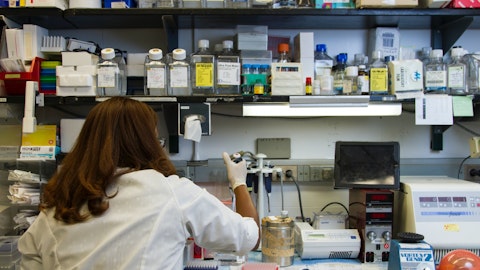Charles Duncan: And then a quick question on the sNDA for the 100 milligram dosage of FIRDAPSE? Probably hard to speculate now, but I am going to ask, what do you think the key questions will be from the agency, will it be around safety or efficacy?
Steven Miller: Well, that’s an interesting question, Charles. The short answer to your question is, if they have any further questions beyond what we’ve already submitted them, and we think that their questions will be relatively sparsed based on our Type C meeting. But with regard to efficacy, they would want to know is the drug efficacious at the 100 milligram dose and we have plenty of data that was submitted in the sNDA that demonstrates efficacy at the 100 milligram dose. The second thing that they would want to know is will the drug be safe at a higher dose, that’s 20% higher than the currently labeled dose of 80 milligrams per day. And again, we submitted a significant body of evidence that showed that there are no safety concerns at a dose of 100 milligrams per day.
And as a result of that, it’s unlikely they’ll have any really hard questions about that, but you can never predict the future. I also want to point something out. Ruzurgi, which was previously approved by the FDA, was approved for a 100 milligram dose. And so as a result, it’s some of that data is actually on our sNDA and it’s for that reason that we also believe that the FDA will be receptive to a 100 milligram dosage application.
Patrick McEnany: Steve, just to put a fine point on that, and that label was pediatric label…
Steven Miller: Yes.
Charles Duncan: Last quick question. Do you plan to have a presence at the upcoming AES Meeting in Orlando, I believe it’s early December, big one for [Indiscernible].
Patrick McEnany: Jeff?
Jeffrey Del Carmen: We will definitely be there. We are going to have a huge presence with our med affairs team as well as our commercial team.
Operator: Next question is coming from Joe Catanzaro from Piper Sandler.
Joe Catanzaro: Maybe two quick ones for me. First one, maybe similar to an earlier question, but wanted to ask about the strategy to price AGAMREE at a slight discount to EMFLAZA. Just wanted to see if you could elaborate around some of the reasons to do that, the potential benefits you see from that, and whether you think that could actually drive more active switching from EMFLAZA on to AGAMREE? That’s my first one and I have one follow-up. Thanks.
Patrick McEnany: Jeff, do you want to speak to some of the work that was done to help us arrive at our pricing?
Jeffrey Del Carmen: So Joe, we’ll provide a lot more details as we get closer to launch. But specific to the pricing and the considerations that we took, we did significant payer outreach as well as speaking with advocacy in patients and then also like KOLs. So that helped us form our decision to price it very similar at a slight discount to EMFLAZA. So those are — that’s the specifics behind that. But do you have — did I answer your question or…
Joe Catanzaro: Yes, that’s helpful. I guess I was primarily interested on whether you could see that as a key factor in the sort of switching dynamic?
Jeffrey Del Carmen: We do anticipate at that price point or a slight discount that there is potential benefits from a payer landscape and not necessitating a further step through EMFLAZA and that was all part of the research too.
Joe Catanzaro: And my second question I wanted to ask around the two key pillars you mentioned, Pat, and the potential to expand the geographic footprints of existing product. I know you mentioned the opportunity for FIRDAPSE in Asia Pacific and Latin America. But wondering based on license agreements if there are any potential opportunities you might see for FYCOMPA and AGAMREE outside of the US? Thanks.
Patrick McEnany: Not for FYCOMPA, Joe. But for AGAMREE again we rather — a license does allow some market expansion. I can’t be specific at the moment about that, but there are some opportunities. Santhera we know is going to market AGAMREE in the five key European markets. And so there are opportunities outside of that for us. They do have a partner already in China. So we have a good working relationship with Santhera. In fact, next week, they’ll be here for a joint development committee meeting and those are topics that are right on the agenda.
Operator: Next question is coming from Scott Henry from ROTH Capital Partners.
Scott Henry: A core competency of Catalyst has really been the access program. Excellent job with Catalyst Pathways. The question is when you compare the LEMS market to the Duchenne’s market, how similar do you think that will be, what are the differences when bringing about access between those markets? I know this seems a little more competitive than the Duchenne’s market. Just any color you would have on that? Thank you.
Patrick McEnany: I’ll let Jeff take this.
Jeffrey Del Carmen: Scott, I mean the biggest difference between the two therapeutic areas, when you look at DMD, not only the competitive landscape that you mentioned but really it’s Medicaid patients, it’s about 50% or so Medicaid and then the balance for the most part is commercial. Whereas the LEMS side, yes, a significant part of the population is Medicare, you have 45% with Medicare and 35% is commercial. So that’s the biggest part there. But the biggest thing for us is that we want to ensure that there is access for all patients that physicians and families think the patient should be on AGAMREE. We want to make sure that there is access for these patients. So we are committed to ensuring that all those patients have an average co-pay of $2 per month. So we’ve done a lot of research, we’ve done a lot of strategy planning and that’s what our focus will be when we launch.
Scott Henry: And then final question, and I don’t know how much you really want talk about this now. But when you compare EMFLAZA to AGAMREE, are there any key differences that will make up your marketing message as far as to promote a switch there? Just trying to think about the key levers that one would compare the two on?
Patrick McEnany: Scott, we continue to do a lot of work. We have primary research and secondary market research and we are not quite ready to open the [indiscernible] entirely with regard to marketing strategies and how we will position ourselves against other programs. Jeff, do you want to add to that?
Jeffrey Del Carmen: So Scott, the thing about the DMD space is it’s a very defined market, and there are about 90 plus — I think we’ve calculated now 103 we profiled centers of excellence or accounts primarily and about 250 prescribers, key prescribers for these boys living with Duchenne. And you know the data has been out there for a long time. And all the stakeholders are pretty much aware of this data and some of the benefits of AGAMREE versus what’s on the market. So we stand behind that data and it will be a collaboration really between commercial and med affairs to ensure that that data is received by the appropriate stakeholders, but that’s been our approach. And like Pat mentioned, we’ll share more specifics about the commercialization here in the next month or two.




